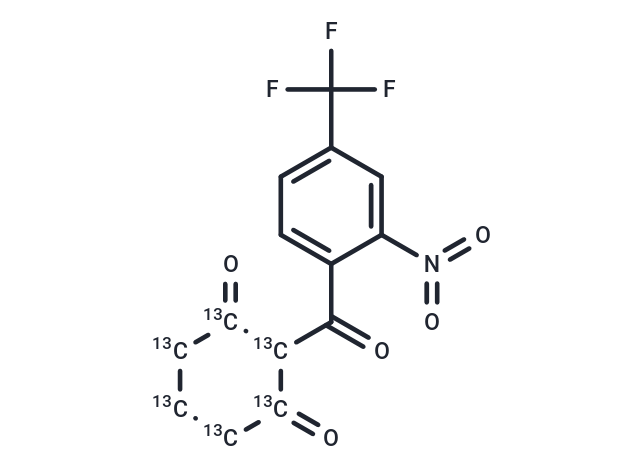- Remove All
 Your shopping cart is currently empty
Your shopping cart is currently empty
Nitisinone-13C6
Nitisinone-13C6is intended for use as an internal standard for the quantification of nitisinone by GC- or LC-MS. Nitisinone is an inhibitor of 4-hydroxyphenylpyruvate dioxygenase (HPPD), which converts 4-hydroxyphenylpyruvate (HPPA) to homogentisate in the tyrosine catabolic pathway.1Nitisinone increases urinary levels of HPPA and 4-hydroxyphenyllactate (HPLA) in rats when administered at a dose of 10 mg/kg. Nitisinone (3 mg/kg) prevents the neonatal lethality of fumarylacetoacetate hydrolase (FAH) deficiency in mice when administered to pregnant dams.2It exhibits hepatoprotective effects inFAH-/-mice, such as prevention of increases in plasma levels of aspartate serine aminotransferase (AST) and conjugated bilirubin, when administration is continued following birth at a dose of 1 mg/kg. Nitisinone (100 μg) decreases urinary excretion of homogentisate and increases urinary excretion of HPPA, HPLA, and 4-hydroxyphenylacetate in a mouse model of alkaptonuria induced by ethylnitrosourea.3Formulations containing nitisinone have been used in the treatment of hereditary tyrosinemia type 1 (HT-1).

Nitisinone-13C6
| Pack Size | Price | Availability | Quantity |
|---|---|---|---|
| 1 mg | $990 | 35 days |
Product Introduction
| Description | Nitisinone-13C6is intended for use as an internal standard for the quantification of nitisinone by GC- or LC-MS. Nitisinone is an inhibitor of 4-hydroxyphenylpyruvate dioxygenase (HPPD), which converts 4-hydroxyphenylpyruvate (HPPA) to homogentisate in the tyrosine catabolic pathway.1Nitisinone increases urinary levels of HPPA and 4-hydroxyphenyllactate (HPLA) in rats when administered at a dose of 10 mg/kg. Nitisinone (3 mg/kg) prevents the neonatal lethality of fumarylacetoacetate hydrolase (FAH) deficiency in mice when administered to pregnant dams.2It exhibits hepatoprotective effects inFAH-/-mice, such as prevention of increases in plasma levels of aspartate serine aminotransferase (AST) and conjugated bilirubin, when administration is continued following birth at a dose of 1 mg/kg. Nitisinone (100 μg) decreases urinary excretion of homogentisate and increases urinary excretion of HPPA, HPLA, and 4-hydroxyphenylacetate in a mouse model of alkaptonuria induced by ethylnitrosourea.3Formulations containing nitisinone have been used in the treatment of hereditary tyrosinemia type 1 (HT-1). 1.Ellis, M.K., Whitfield, A.C., Gowans, L.A., et al.Inhibition of 4-hydroxyphenylpyruvate dioxygenase by 2-(2-nitro-4-trifluoromethylbenzoyl)-cyclohexane-1,3-dione and 2-(2-chloro-4-methanesulfonylbenzoyl)-cyclohexane-1,3-dioneToxicol. Appl. Pharmacol.133(1)12-19(1995) 2.Grompe, M., Lindstedt, S., al-Dhalimy, M., et al.Pharmacological correction of neonatal lethal hepatic dysfunction in a murine model of hereditary tyrosinaemia type INat. Genet.10(4)453-460(1995) 3.Suzuki, Y., Oda, K., Yoshikawa, Y., et al.A novel therapeutic trial of homogentisic aciduria in a murine model of alkaptonuriaJ. Hum. Genet.44(2)79-84(1999) |
| Alias | Nitisinone-13C6 |
| Molecular Weight | 335.185 |
| Formula | C14H10F3NO5 |
| Cas No. | 1246815-63-3 |
| Relative Density. | no data available |
| Storage | Powder: -20°C for 3 years | In solvent: -80°C for 1 year | Shipping with blue ice. |
| Solubility Information | Chloroform: Slightly soluble Ethyl Acetate: Slightly soluble |
Sci Citations
Calculator
In Vivo Formulation Calculator (Clear solution)
Dose Conversion
Tech Support

Copyright © 2015-2025 TargetMol Chemicals Inc. All Rights Reserved.




